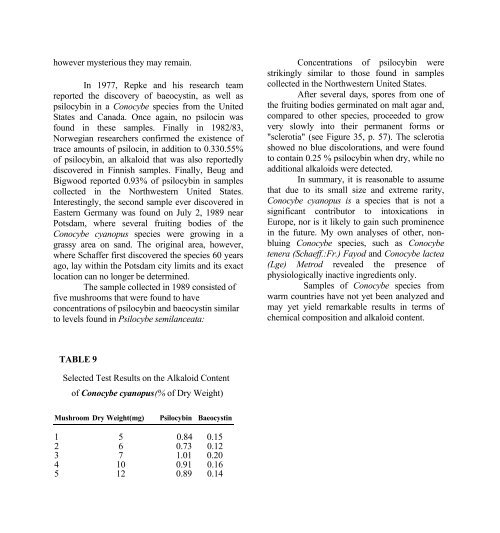Jochen Gartz - Magic Mushrooms Around the ... - preterhuman.net
Jochen Gartz - Magic Mushrooms Around the ... - preterhuman.net
Jochen Gartz - Magic Mushrooms Around the ... - preterhuman.net
Create successful ePaper yourself
Turn your PDF publications into a flip-book with our unique Google optimized e-Paper software.
however mysterious <strong>the</strong>y may remain.<br />
In 1977, Repke and his research team<br />
reported <strong>the</strong> discovery of baeocystin, as well as<br />
psilocybin in a Conocybe species from <strong>the</strong> United<br />
States and Canada. Once again, no psilocin was<br />
found in <strong>the</strong>se samples. Finally in 1982/83,<br />
Norwegian researchers confirmed <strong>the</strong> existence of<br />
trace amounts of psilocin, in addition to 0.330.55%<br />
of psilocybin, an alkaloid that was also reportedly<br />
discovered in Finnish samples. Finally, Beug and<br />
Bigwood reported 0.93% of psilocybin in samples<br />
collected in <strong>the</strong> Northwestern United States.<br />
Interestingly, <strong>the</strong> second sample ever discovered in<br />
Eastern Germany was found on July 2, 1989 near<br />
Potsdam, where several fruiting bodies of <strong>the</strong><br />
Conocybe cyanopus species were growing in a<br />
grassy area on sand. The original area, however,<br />
where Schaffer first discovered <strong>the</strong> species 60 years<br />
ago, lay within <strong>the</strong> Potsdam city limits and its exact<br />
location can no longer be determined.<br />
The sample collected in 1989 consisted of<br />
five mushrooms that were found to have<br />
concentrations of psilocybin and baeocystin similar<br />
to levels found in Psilocybe semilanceata:<br />
Concentrations of psilocybin were<br />
strikingly similar to those found in samples<br />
collected in <strong>the</strong> Northwestern United States.<br />
After several days, spores from one of<br />
<strong>the</strong> fruiting bodies germinated on malt agar and,<br />
compared to o<strong>the</strong>r species, proceeded to grow<br />
very slowly into <strong>the</strong>ir permanent forms or<br />
"sclerotia" (see Figure 35, p. 57). The sclerotia<br />
showed no blue discolorations, and were found<br />
to contain 0.25 % psilocybin when dry, while no<br />
additional alkaloids were detected.<br />
In summary, it is reasonable to assume<br />
that due to its small size and extreme rarity,<br />
Conocybe cyanopus is a species that is not a<br />
significant contributor to intoxications in<br />
Europe, nor is it likely to gain such prominence<br />
in <strong>the</strong> future. My own analyses of o<strong>the</strong>r, nonbluing<br />
Conocybe species, such as Conocybe<br />
tenera (Schaeff.:Fr.) Fayod and Conocybe lactea<br />
(Lge) Metrod revealed <strong>the</strong> presence of<br />
physiologically inactive ingredients only.<br />
Samples of Conocybe species from<br />
warm countries have not yet been analyzed and<br />
may yet yield remarkable results in terms of<br />
chemical composition and alkaloid content.<br />
TABLE 9<br />
Selected Test Results on <strong>the</strong> Alkaloid Content<br />
of Conocybe cyanopus (% of Dry Weight)<br />
Mushroom Dry Weight(mg) Psilocybin Baeocystin<br />
1 5 0.84 0.15<br />
2<br />
3<br />
6<br />
7<br />
0.73<br />
1.01<br />
0.12<br />
0.20<br />
4<br />
5<br />
10<br />
12<br />
0.91<br />
0.89<br />
0.16<br />
0.14








![The Big Lie 9-11 and Government Complicity in Mass Murder [PDF]](https://img.yumpu.com/50957077/1/190x245/the-big-lie-9-11-and-government-complicity-in-mass-murder-pdf.jpg?quality=85)








